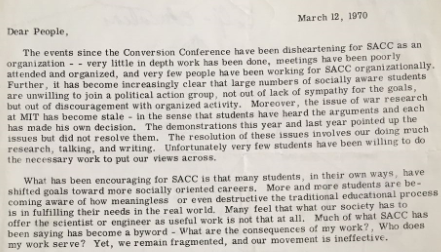As someone with a strong interest in the history of activism and involvement with activism on MIT’s campus, choosing my project for Media in Cultural Context was easy: there is a huge archive of one of MIT’s student activist groups, the Science Action Coordinating Committee (SACC), which mobilized in 1968 in response to military research on MIT’s campus and the Vietnam War. As my research on SACC progressed, I realized that much of the conclusions I had drawn could be of use for activists on MIT’s campus today.
Perhaps my most encouraging finding was that MIT students draw disproportionate press attention simply by being MIT students. The most striking case of this occurred when SACC proposed its first action, a campus-wide voluntary research stoppage to take place on March 4, 1969, and received extensive coverage in the Boston Globe, the New York Times and other nationwide publications. Further, when this tactic was reported at MIT, it quickly caught on at other universities across the nation, making March 4 a nationwide event to raise awareness of Department of Defense funding for potentially harmful military research on campus. The influence of SACC is even more striking when the size of the group is taken into account: most listings of the group’s members contain no more than five or six people.
Thus, MIT student activists find themselves in a peculiar position: it is certainly unfair that student activists receive increased media attention merely because they attend an “elite” institution, but it is perhaps useful to take advantage of this fact to amplify the impact of collective actions.
Like many activist groups, SACC stagnated short after its initial success. Below is the beginning of letter to SACC members, dated just a little over a year after the March 4 movement, which cites low participation and “discouragement with organized activity” as SACC’s plight:

In my experience with activism on MIT’s campus, these concerns are exceedingly relatable. MIT students are notoriously busy and lacking in political engagement. However, we can benefit from the efforts of SACC by learning from their experiences. In this case, the letter goes on to propose possible solutions, such as implementing a more formal group structure or coalition building with Boston-based groups that share similar goals, like Science for the People. It is unclear whether or not these efforts were successful, but, in any case, there is a clear consolation: in the short time that SACC was active they were able to reach many students who became “sympathetic with SACC’s goals” and “shifted towards more socially oriented careers.”
As a final note of encouragement, I will merely point to the fact that activists on MIT’s campus today have one clear advantage over SACC—the Internet. SACC’s mailing lists were actual paper lists of addresses, they had to write letters and wait for responses, and they could only publicize their events with posters and leaflets. With the use of the Internet, activists today can reach a wider audience with less effort, which might help in overcoming struggles with low participation.


